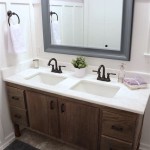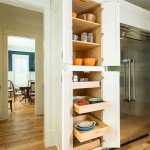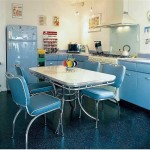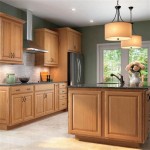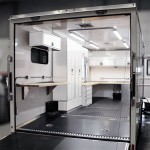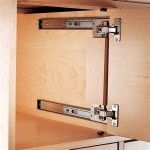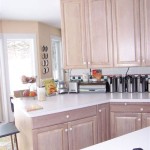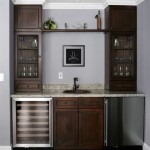How To Paint Wood Kitchen Cabinets: A Comprehensive Guide
Painting wood kitchen cabinets is a cost-effective way to revitalize a kitchen's appearance without the expense of a full remodel. It requires careful planning, preparation, and execution to achieve a professional and durable finish. This article details the necessary steps, materials, and techniques involved in successfully painting wood kitchen cabinets.
Key Point 1: Preparation is Paramount
The quality of the final paint job is directly proportional to the thoroughness of the preparation. Skimping on this stage will invariably lead to problems such as poor adhesion, uneven coverage, and a less-than-desirable aesthetic.
1. Removal of Hardware: The first step involves removing all hardware, including knobs, pulls, hinges, and any other decorative elements. This ensures a clean, unobstructed surface for painting. Label each piece of hardware and its corresponding cabinet door or drawer to facilitate reinstallation. Store all hardware in a safe place to prevent loss or damage.
2. Cleaning and Degreasing: Kitchen cabinets accumulate grease, grime, and food splatters over time. These contaminants must be thoroughly removed to allow the paint to adhere properly. Use a strong degreasing cleaner specifically designed for kitchen surfaces. Apply the cleaner according to the manufacturer's instructions, paying particular attention to areas around handles and near the stove. Rinse thoroughly with clean water and allow the cabinets to dry completely.
3. Sanding: Sanding is crucial for creating a slightly roughened surface that paint can grip. Use medium-grit sandpaper (120-150 grit) to lightly sand all surfaces to be painted. Focus on removing the existing finish and smoothing out any imperfections. For heavily varnished or glossy surfaces, a coarser grit (80-100 grit) may be necessary initially, followed by a pass with medium-grit sandpaper. Sand with the grain of the wood to avoid creating scratches. After sanding, thoroughly remove all sanding dust with a tack cloth or a vacuum cleaner with a brush attachment. Failure to remove sanding dust will result in a bumpy and uneven finish.
4. Filling Holes and Imperfections: Inspect the cabinets for any holes, dents, or imperfections. Fill these with wood filler, applying it smoothly and evenly. Allow the wood filler to dry completely according to the manufacturer's instructions. Once dry, sand the filled areas smooth with fine-grit sandpaper (220 grit) to blend seamlessly with the surrounding surface. Again, remove all sanding dust.
5. Priming: Priming is an essential step, as it seals the wood, provides a uniform surface for the paint to adhere to, and prevents the paint from being absorbed unevenly. Use a high-quality primer specifically designed for use on wood. Oil-based primers are excellent for blocking stains and tannins from bleeding through the paint, while latex primers are easier to clean up and have lower VOCs. Apply the primer in thin, even coats using a brush, roller, or sprayer. Allow the primer to dry completely according to the manufacturer's instructions before proceeding to the next step. Lightly sand the primed surface with fine-grit sandpaper (220 grit) to create an even smoother surface for the paint. Clean the surface again, removing any dust created from the sanding.
Key Point 2: Choosing the Right Paint and Application Method
Selecting the appropriate paint and application method is vital for achieving a durable and aesthetically pleasing finish. Considerations include the type of paint, sheen, and application tools.
1. Paint Selection: The best type of paint for kitchen cabinets is typically a high-quality acrylic latex or alkyd paint. Acrylic latex paints are durable, easy to clean, and have low VOCs. Alkyd paints offer a harder, more durable finish but require mineral spirits for cleanup and have higher VOCs. Consider a paint specifically formulated for cabinets and trim for optimal performance. Avoid using flat paint, as it is difficult to clean. Select a paint with a sheen level that aligns with aesthetic preferences and functional needs; satin or semi-gloss finishes are commonly used for kitchen cabinets because they are durable and easy to wipe clean.
2. Application Methods: There are three primary methods for applying paint to kitchen cabinets: brush, roller, and sprayer. Each method has its advantages and disadvantages.
- Brush: Brushing is a cost-effective method that is suitable for smaller projects or intricate details. Use a high-quality synthetic brush designed for latex or alkyd paints, depending on the chosen paint type. Apply the paint in thin, even strokes, following the grain of the wood. Be mindful of brushstrokes and avoid applying too much paint, which can lead to drips and uneven coverage.
- Roller: Rolling is a good option for painting large, flat surfaces. Use a foam roller or a roller with a short nap for a smooth finish. Apply the paint in thin, even coats, overlapping each pass slightly. Rollers can leave a slightly textured finish, which may or may not be desirable depending on the aesthetic preference.
- Sprayer: Spraying provides the most professional-looking finish, as it delivers a smooth, even coat of paint without brushstrokes or roller marks. However, it requires more preparation, including masking off the surrounding areas to protect them from overspray. An airless sprayer or an HVLP (high-volume, low-pressure) sprayer can be used. Thin the paint according to the manufacturer's instructions for optimal spraying performance. Practice spraying on a scrap piece of wood before applying paint to the cabinets to refine technique and adjust the sprayer settings.
3. Number of Coats: Apply at least two coats of paint for optimal coverage and durability. Allow each coat to dry completely according to the manufacturer's instructions before applying the next coat. Lightly sand between coats with fine-grit sandpaper (220 grit or higher) to remove any imperfections and create a smoother surface for the next coat.
Key Point 3: Reassembly and Final Touches
Once the paint has dried completely, the cabinets can be reassembled, and any final touches can be addressed. This stage requires care and attention to detail to ensure a professional and polished final result.
1. Reinstallation of Hardware: Carefully reattach the hardware using the labels that were created during the removal process. Ensure that all screws are tightened securely. Consider replacing old or outdated hardware with new hardware to further enhance the appearance of the cabinets. New hardware can provide a significant aesthetic upgrade and complement the fresh paint job.
2. Caulking: Apply caulk along any seams or gaps between the cabinets and the walls or countertops. This will create a seamless and professional look and prevent moisture from entering the cabinets. Use a paintable caulk and apply it smoothly and evenly. Wipe away any excess caulk with a damp cloth.
3. Touch-Ups: Inspect the cabinets for any missed spots or imperfections. Touch up these areas with a small brush and the remaining paint. Allow the touch-up paint to dry completely before using the cabinets.
4. Cleaning: Clean the painted cabinets with a mild soap and water solution. Avoid using harsh chemicals or abrasive cleaners, as these can damage the paint finish. Wipe the cabinets dry with a soft cloth.
5. Curing Time: Allow the paint to fully cure for several days or even weeks, depending on the type of paint used. During this time, avoid excessive use or cleaning of the cabinets. This will allow the paint to harden and achieve its maximum durability.
By following these steps carefully and paying attention to detail, it is possible to achieve a professional-looking paint job on wood kitchen cabinets. The result will be a refreshed and revitalized kitchen space without the significant expense of replacing the cabinets.
Choosing to paint cabinets, instead of replacing them, can be a sound financial decision, but it is essential to factor in the time and effort required to complete the project successfully. Professional painters often charge a significant amount for this type of work, so doing it yourself can save a substantial amount of money. However, it is important to be realistic about your skills and abilities and to be prepared to invest the necessary time and effort to achieve a satisfactory result.
Furthermore, consider the impact of the color choice on the overall look and feel of the kitchen. Lighter colors can brighten up a dark kitchen and make it feel more spacious, while darker colors can add warmth and sophistication. It's also important to consider the existing colors in the kitchen, such as the countertops, backsplash, and flooring, to ensure that the new cabinet color complements the overall design.
Before embarking on this project, research the different types of paint available and choose one that is specifically designed for kitchen cabinets. A high-quality paint will provide a durable and long-lasting finish that can withstand the rigors of daily use. Also, be sure to follow the manufacturer's instructions for application and drying times. Proper preparation, a good paint, and careful application are all essential for achieving a professional-looking result.
Finally, remember that patience is key. Painting kitchen cabinets is a time-consuming process that requires attention to detail. Don't rush through any of the steps, and be prepared to spend several days or even weeks completing the project. The end result will be a beautifully transformed kitchen that you can enjoy for years to come.

Tips Tricks To Paint Honey Oak Kitchen Cabinets Cottage Living And Style

How To Paint Kitchen Cabinets Forbes Home

How To Paint Kitchen Cabinets A Step By Guide Confessions Of Serial Do It Yourselfer

How To Paint Oak Cabinets And Hide The Grain Tutorial

How To Paint Kitchen Cabinets The Love Notes Blog

Tips Tricks To Paint Honey Oak Kitchen Cabinets Cottage Living And Style

How To Paint Kitchen Cabinets White In 5 Days For 150 The Nutritionist Reviews
:strip_icc()/101671998-27cdf40f639448d0a56ff6c7eab609d7.jpg?strip=all)
Expert Tips For Painting Oak Cabinets

How To Paint Fake Wood Kitchen Cabinets Simple Made Pretty 2024

How To Paint Oak Cabinets And Hide The Grain Tutorial
Related Posts

